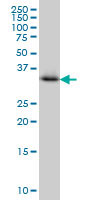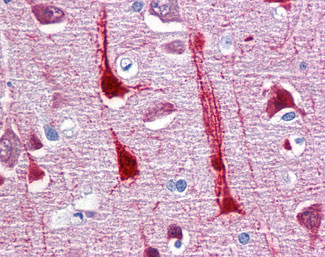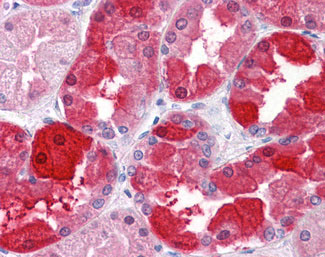CRYM Antibody (clone 6B3)
Mouse Monoclonal Antibody
- SPECIFICATION
- CITATIONS
- PROTOCOLS
- BACKGROUND

Application
| WB, IHC-P, E |
|---|---|
| Primary Accession | Q14894 |
| Reactivity | Human |
| Host | Mouse |
| Clonality | Monoclonal |
| Clone Names | 6B3 |
| Calculated MW | 34kDa |
| Dilution | IHC-P (5 µg/ml) |
| Gene ID | 1428 |
|---|---|
| Other Names | Ketimine reductase mu-crystallin, 1.5.1.25, NADP-regulated thyroid-hormone-binding protein, CRYM, THBP |
| Reconstitution & Storage | Store at -20°C. Aliquot to avoid freeze/thaw cycles. |
| Precautions | CRYM Antibody (clone 6B3) is for research use only and not for use in diagnostic or therapeutic procedures. |
| Name | CRYM (HGNC:2418) |
|---|---|
| Function | Catalyzes the NAD(P)H-dependent reduction of imine double bonds of a number of cyclic ketimine substrates, including sulfur- containing cyclic ketimines (PubMed:21332720, PubMed:25931162). Under physiological conditions, it efficiently catalyzes delta(1)- piperideine-2-carboxylate (P2C) and delta(1)-pyrroline-2-carboxylate (Pyr2C) reduction, suggesting a central role in lysine and glutamate metabolism (PubMed:25931162). Additional substrates are delta(2)- thiazoline-2-carboxylate (T2C), 3,4-dehydrothiomorpholine-3-carboxylate (AECK), and (R)-lanthionine ketimine (LK) that is reduced at very low rate compared to other substrates (PubMed:25931162). Also catalyzes the NAD(P)H-dependent reduction of (S)-cystathionine ketimine (CysK) (By similarity). |
| Cellular Location | Cytoplasm. |
| Tissue Location | Expressed in neural tissues, muscle and kidney (PubMed:1384048). Expressed in the inner ear (PubMed:12471561) |

Thousands of laboratories across the world have published research that depended on the performance of antibodies from Abcepta to advance their research. Check out links to articles that cite our products in major peer-reviewed journals, organized by research category.
info@abcepta.com, and receive a free "I Love Antibodies" mug.
Provided below are standard protocols that you may find useful for product applications.
Background
Specifically catalyzes the reduction of imine bonds in brain substrates that may include cystathionine ketimine (CysK) and lanthionine ketimine (LK). Binds thyroid hormone which is a strong reversible inhibitor. Presumably involved in the regulation of the free intracellular concentration of triiodothyronine and access to its nuclear receptors.
References
Segovia L.,et al.Mol. Vis. 3:9-9(1997).
Vie M.-P.,et al.Mol. Endocrinol. 11:1728-1736(1997).
Sperbeck S.J.,et al.Submitted (DEC-1997) to the EMBL/GenBank/DDBJ databases.
Loftus B.J.,et al.Genomics 60:295-308(1999).
Ota T.,et al.Nat. Genet. 36:40-45(2004).
If you have used an Abcepta product and would like to share how it has performed, please click on the "Submit Review" button and provide the requested information. Our staff will examine and post your review and contact you if needed.
If you have any additional inquiries please email technical services at tech@abcepta.com.













 Foundational characteristics of cancer include proliferation, angiogenesis, migration, evasion of apoptosis, and cellular immortality. Find key markers for these cellular processes and antibodies to detect them.
Foundational characteristics of cancer include proliferation, angiogenesis, migration, evasion of apoptosis, and cellular immortality. Find key markers for these cellular processes and antibodies to detect them. The SUMOplot™ Analysis Program predicts and scores sumoylation sites in your protein. SUMOylation is a post-translational modification involved in various cellular processes, such as nuclear-cytosolic transport, transcriptional regulation, apoptosis, protein stability, response to stress, and progression through the cell cycle.
The SUMOplot™ Analysis Program predicts and scores sumoylation sites in your protein. SUMOylation is a post-translational modification involved in various cellular processes, such as nuclear-cytosolic transport, transcriptional regulation, apoptosis, protein stability, response to stress, and progression through the cell cycle. The Autophagy Receptor Motif Plotter predicts and scores autophagy receptor binding sites in your protein. Identifying proteins connected to this pathway is critical to understanding the role of autophagy in physiological as well as pathological processes such as development, differentiation, neurodegenerative diseases, stress, infection, and cancer.
The Autophagy Receptor Motif Plotter predicts and scores autophagy receptor binding sites in your protein. Identifying proteins connected to this pathway is critical to understanding the role of autophagy in physiological as well as pathological processes such as development, differentiation, neurodegenerative diseases, stress, infection, and cancer.




